Big Events Pose Big Communications Challenges
MILCOM 2009's first panelists spoke about the practical challenges of the convergence of communications capabilities.
MILCOM 2009's first panelists spoke about the practical challenges of the convergence of communications capabilities. Representatives from U.S. government agencies as well as local law enforcement agreed that plans for emergencies and special security events must involve collaboration and preparation, but they also admitted that a plan is just that-a plan. Everyone involved in the command and control of these activities-from the cop on the beat to the person in charge-must be ready for the unexpected. Representatives from the Boston Police Department shared their insights about the various special events that have required unusual security and communications to ensure the safety of the citizens. During the past several years, in addition to annual events such as the Boston Marathon and Independence Day celebrations, the department has dealt with sports teams' championship-winning partying and the Democratic National Convention. Each event presented its own set of challenges, and the department continues to improve; however, planning and practice are still needed for the problems an act of terrorism would cause, Daniel Linskey, superintendent-in-chief, Boston Police Department, said. Lt. Kevin Buckley, tactical operations team, Boston Police Department, shared that while the city's law enforcement personnel has the advantage of state-of-the-art technologies, many of the smaller localities around the city cannot afford the latest communications gear. Finding themselves in situations where interoperability becomes an issue, they adapt, but "we're not really there. We've come to a certain point, but we have a long way to go in my opinion," Buckley said. From the Secret Service, David O'Connor, special agent in charge for the dignitary protective division, spoke about the presidential inauguration and the challenges that particular event-as well as activities surrounding it-posed. Although the event was a huge success with very few incidents-none serious-there was an issue with crowds backed up in the Third Street Tunnel that gained national attention. The special agent explained that people were going from north to south rather than south to north as was the plan. When alerted that there were people in the tunnel, O'Connor's staff was not concerned: they expected the crowds. But when up on The Hill the next day, O'Connor heard for the first time about "a thing called Twitter. I was told that if I'd been monitoring Twitter, I would have been more cognizant of what was happening in the Third Street Tunnel. ...I can assure you that at the most recent G-20 Partnership [in Pittsburgh], we did have Twitter access." Robert Lentz, moderator, posed several questions to the panelists for discussion. While it was evident from the panelists' presentations that their organizations were getting better all the time when connected during special events, he asked if they also practiced what to do when networks go down, either by accident or design as part of a terrorist attack. Members of the panel agreed that they are prepared to go back to the way activities were conducted before networks were available, but they admitted that they do not practice this scenario nearly as much as they should. In response to Lentz's question about whether government users of commercial technologies are aware of all the vulnerabilities of using these tools for official business, O'Connor responded that public-private partnerships are the best way to ensure information security when commercial products are used in this manner.



